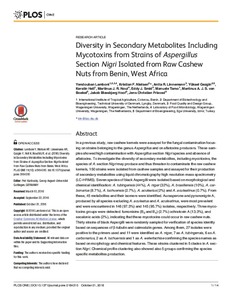| dc.contributor.author | Lamboni, Y. |
| dc.contributor.author | Nielsen, K.F. |
| dc.contributor.author | Linnemann, A. |
| dc.contributor.author | Gezgin, Y. |
| dc.contributor.author | Hell, K. |
| dc.contributor.author | Nout, R.M. |
| dc.contributor.author | Smid, E.J. |
| dc.contributor.author | Tamo, M. |
| dc.contributor.author | Boekel, M.A. van |
| dc.contributor.author | Hoof, J.B. |
| dc.contributor.author | Frisvad, J.C. |
| dc.date.accessioned | 2019-12-04T11:04:41Z |
| dc.date.available | 2019-12-04T11:04:41Z |
| dc.date.issued | 2016-10-21 |
| dc.identifier.citation | Lamboni, Y., Nielsen, K.F., Linnemann, A., Gezgin, Y., Hell, K., Nout, R.M., ... & Frisvad, J.C. (2016). Diversity in secondary metabolites including mycotoxins from strains of aspergillus section nigri isolated from raw cashew nuts from Benin, West Africa. PLoS One, 11(10), 1-14. |
| dc.identifier.issn | 1932-6203 |
| dc.identifier.uri | https://hdl.handle.net/20.500.12478/1483 |
| dc.description | Open access Journal |
| dc.description.abstract | In a previous study, raw cashew kernels were assayed for the fungal contamination focusing on strains belonging to the genus Aspergillus and on aflatoxins producers. These samples showed high contamination with Aspergillus section Nigri species and absence of aflatoxins. To investigate the diversity of secondary metabolites, including mycotoxins, the species of A. section Nigri may produce and thus threaten to contaminate the raw cashew kernels, 150 strains were isolated from cashew samples and assayed for their production of secondary metabolites using liquid chromatography high resolution mass spectrometry (LC-HRMS). Seven species of black Aspergilli were isolated based on morphological and chemical identification: A. tubingensis (44%), A. niger (32%), A. brasiliensis (10%), A. carbonarius (8.7%), A. luchuensis (2.7%), A. aculeatus (2%) and A. aculeatinus (0.7%). From these, 45 metabolites and their isomers were identified. Aurasperone and pyranonigrin A, produced by all species excluding A. aculeatus and A. aculeatinus, were most prevalent and were encountered in 146 (97.3%) and 145 (95.7%) isolates, respectively. Three mycotoxins groups were detected: fumonisins (B2 and B4) (2.7%) ochratoxin A (13.3%), and secalonic acids (2%), indicating that these mycotoxins could occur in raw cashew nuts. Thirty strains of black Aspergilli were randomly sampled for verification of species identity based on sequences of β-tubulin and calmodulin genes. Among them, 27 isolates were positive to the primers used and 11 were identified as A. niger, 7 as A. tubingensis, 6 as A. carbonarius, 2 as A. luchuensis and 1 as A. welwitschiae confirming the species names as based on morphology and chemical features. These strains clustered in 5 clades in A. section Nigri. Chemical profile clustering also showed also 5 groups confirming the species specific metabolites production. |
| dc.format.extent | 1-14 |
| dc.language.iso | en |
| dc.subject | Mycotoxins |
| dc.subject | Aspergillus |
| dc.subject | Metabolites |
| dc.subject | Nuts |
| dc.subject | Cashew |
| dc.title | Diversity in secondary metabolites including mycotoxins from strains of aspergillus section nigri isolated from raw cashew nuts from Benin, West Africa |
| dc.type | Journal Article |
| dc.description.version | Peer Review |
| cg.contributor.affiliation | International Institute of Tropical Agriculture |
| cg.contributor.affiliation | Technical University of Denmark |
| cg.contributor.affiliation | Wageningen University and Research Centre |
| cg.contributor.affiliation | Ege University |
| cg.coverage.region | Africa |
| cg.coverage.region | West Africa |
| cg.coverage.country | Benin |
| cg.isijournal | ISI Journal |
| cg.authorship.types | CGIAR and developing country institute |
| cg.iitasubject | Food Security |
| cg.iitasubject | Pests Of Plants |
| cg.journal | PloS ONE |
| cg.howpublished | Formally Published |
| cg.accessibilitystatus | Open Access |
| local.dspaceid | 80668 |
| cg.targetaudience | Scientists |
| cg.identifier.doi | https://dx.doi.org/10.1371/journal.pone.0164310 |

